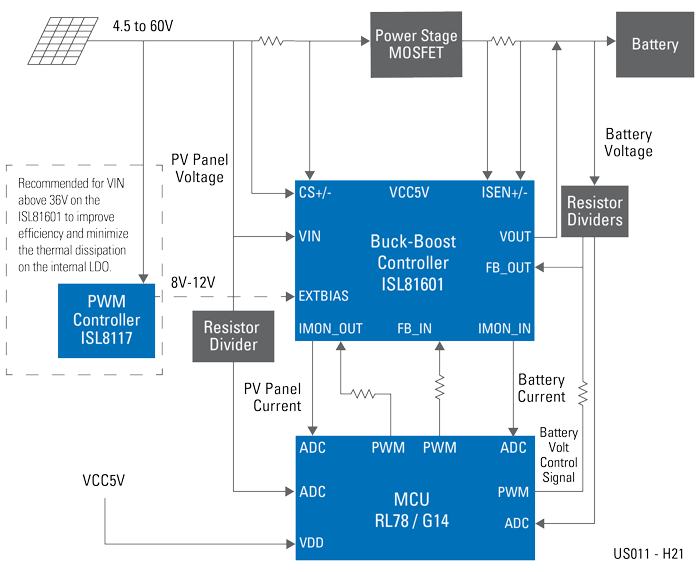Using a solar cell to charge a battery is a very popular application. However, solar cells also present challenges because of the wide variability of the output voltage of the cell. The output voltage depends on the amount of solar energy directed at the panel, the temperature of the system, and the load on the panel. While additional hardware components can mitigate the negative effects of these factors, for example, by rotating panels to follow the sun, the system remains in need of a power conditioning circuit that can tolerate a wide input voltage range.
The ISL81601 buck-boost controller provides an excellent means to resolve the wide variability issue in systems operating up to 60V because it can accept input voltages from 4.5V to 60V and deliver 0.8V to 60V on the output. This allows the design to interface with numerous solar panel setups, even if the solar panel is delivering an output voltage much lower than its nominal output, and also allows the system to charge a wide array of battery voltages.
Providing accurate currents and voltages to the battery is another challenge in a solar charging system. The ISL81601 provides input and output telemetry for both current and voltage plus built-in protection for a variety of potential situations such as OVP, UVP, OTP, and protections for both average and peak currents. Selectable constant current and constant voltage modes are used along with an MCU such as the RL78/G14 to ensure that the battery is safely and correctly charged. The buck-boost controller also provides a regulated 5V to power the MCU via an internal linear regulator. The RL78/G14 can further improve the system by running a program to implement maximum power point tracking (MPPT) and maximize the power converted from the solar cell.

For power-dense systems, thermal dissipation is particularly important. The ISL81601 drives external MOSFETs to accommodate currents of 10A or more and provides an external bias pin for the internal LDO that can be used to avoid excess heat in the device and the system. It is recommended to power the external bias pin from an 8V or higher rail when the input voltage to the buck-boost controller is above 36V or larger loads are placed on the internal regulator. The ISL8117 is a DC/DC buck controller that accepts up to 60V on the input and can provide 8V to the external bias pin, or a 12V rail for both the external bias pin and an additional system rail.
The ISL81601 is a very versatile device, and when used in a solar charging application, the built-in features ease the creation of a sophisticated battery charging system without the associated costs and delays that users would experience using alternative solutions.
Visit renesas.com/winning-combinations to see more winning combination solutions that help our customers accelerate their designs to get to market faster.
